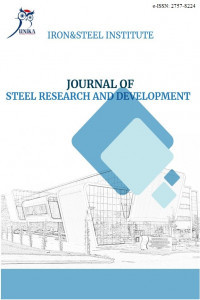Sharfuldeen Ali Abourawi ALFAYDH, Harun ÇUĞ, Yasin AKGÜL, Alper İNCESU, Andinet Kumella ETİCHA, Salih Birhanu AHMED
Sementasyon İşleminin Sıcak İş Takım Çeliklerinin Aşınma Davranışına Etkisinin İncelenmesi
Bu çalışmada, iki farklı süre (3 saat ve 6 saat ) ve iki farklı sıcaklıkta (800 °C ve 930 °C) gerçekleştirilen kutu sementasyon işlemlerinin AISI H13 sıcak iş takım çeliğinin kuru ve korozif (%3,5 NaCl çözeltisi) ortamdaki aşınma davranışlarına etkileri incelenmiştir. Numunelerin sementasyona uğramış yüzeylerinin kesitleri Taramalı Elektron Mikroskobu ile incelenmiş, sementasyona bağlı sertlik değişimleri Vickers mikro sertlik ölçümü ile değerlendirilmiştir. En yüksek sertlik değerine (1011 HV) 930 °C’de 3 saat sementasyona uğratılan numunede ulaşılmıştır. Artan yüzey sertliğine bağlı olarak kuru ortamda en yüksek aşınma direncine de 930 °C’de 3 saat sementasyona uğratılan numune sahiptir. Korozif ortamda yapılan aşınma testinde ise sementasyona uğramamış AISI H13 sıcak iş takım çeliğinin daha yüksek aşınma direncine sahip olduğu anlaşılmıştır.
Anahtar Kelimeler:
Sementasyon, Takım çelikleri, Aşınma, Sertlik, Cementation, Tool steels, Wear, Hardness
Investigation of the Effect of Cementation Process on the Wear Behavior of Hot Work Tool Steels
In this study, the effects of pack cementation processes performed for two different durations (3 hours and 6 hours) and two different temperatures (800 °C and 930 °C) on the wear behavior of AISI H13 hot tool steel in dry and corrosive (3.5% NaCl solution) environments were investigated. The sections of cemented surfaces of the samples were examined by Scanning Electron Microscope and the hardness changes due to cementation were evaluated by Vickers micro hardness measurement. The highest hardness value (1011 HV) was reached in the sample cemented at 930 °C for 3 hours. Due to the increased surface hardness, the sample cemented for 3 hours at 930 °C has the highest wear resistance in a dry environment. In the abrasion test carried out in a corrosive environment, it was found that AISI H13 hot work tool steel, which has not been cemented, has a higher abrasion resistance.
Keywords:
Cementation, Tool steels, Wear, Hardness,
___
- S.-H. Chang, T.-P. Tang, Y.-C. Chen, and J.-K. Chen, ‘Enhancement of erosion resistance on AISI H13 tool steel by oxynitriding treatment’, ISIJ Int., vol. 49, no. 3, pp. 421–424, 2009.
- S.-H. Chang, S.-C. Lee, and T.-P. Tang, ‘Effect of shot peening treatment on forging die life’, Mater. Trans., vol. 49, no. 3, pp. 619–623, 2008.
- S.-H. Chang, K.-T. Huang, and Y.-H. Wang, ‘Effects of thermal erosion and wear resistance on AISI H13 tool steel by various surface treatments’, Mater. Trans., vol. 53, no. 4, pp. 745–751, 2012.
- S. A. Gerasimov et al., ‘Mechanical properties of hot-working steels after activization of cementation process’, J. Mach. Manuf. Reliab., vol. 43, no. 4, pp. 322–326, 2014.
- G. B. Stachowiak, G. W. Stachowiak, and P. Evans, ‘Wear and friction characteristics of ion-implanted zirconia ceramics’, Wear, vol. 241, no. 2, pp. 220–227, 2000.
- D. Starosvetsky and I. Gotman, ‘TiN coating improves the corrosion behavior of superelastic NiTi surgical alloy’, Surf. Coat. Technol., vol. 148, no. 2–3, pp. 268–276, 2001.
- M. Zeng, Y. Yang, and M. Li, ‘Microstructure and Pitting Corrosion Resistance of Titanizing Coating Prepared by Pack Cementation on 316L Stainless Steel’, Int. J. Electrochem. Sci., vol. 16, no. 7, 2021.
- M. Lachowicz, ‘Corrosive Wear of the Selected Tool Steels’, Tribologia, 2019.
- Başlangıç: 2020
- Yayıncı: Karabük Üniversitesi
Sayıdaki Diğer Makaleler
Mehmet Akif ERDEN, Abkar Ahmed Ali DHAIBAIN, Ahmet Serdar GÜLDİBİ
Borlama prosesinin 16MnCr5 çeliklerinin aşınma performansına etkisi
Ali Yağız ŞAHİN, Muhammet Emre TURAN
Senol LİMAN, Bünyamin ÇİÇEK, Tuna AYDOĞMUŞ
Mehmet Akif ERDEN, Ramazan ÖZMEN
Sementasyon İşleminin Sıcak İş Takım Çeliklerinin Aşınma Davranışına Etkisinin İncelenmesi
Sharfuldeen Ali Abourawi ALFAYDH, Harun ÇUĞ, Yasin AKGÜL, Alper İNCESU, Andinet Kumella ETİCHA, Salih Birhanu AHMED
